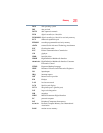
Glossary
233
application — A computer program that you use to perform tasks of a
specific type. Applications include word processors, spreadsheets,
and database management systems. See also program.
B
backup — A copy of a file, usually on a removable disk, kept in case the
original file is lost or damaged.
basic input/output system (BIOS) — See BIOS.
baud rate — The speed at which a communication device, such as a
printer or modem, transmits information. Baud rate is the number of
signal changes per second (not necessarily the same as bits per
second). See also bits per second.
BIOS (basic input/output system) — Basic instructions, stored in read-
only memory (ROM), containing the information the computer
needs to check hardware and load the operating system when you
start up the computer.
bits per second (bps) — A way of measuring the speed at which
information is passed between two devices. This is the basic unit of
measure used in modem communications, and is similar, but not
identical, to the baud rate. See also baud rate.
boot — To start the computer. The term “boot” originates from bootstrap
program (as in “pulling itself up by its bootstraps”), a program that
loads and initializes the operating system. See also reboot.
boot disk — See system disk.
boot priority (startup sequence) — The order in which the computer
accesses its internal storage drives to locate the startup files. Under
the default startup sequence, the computer looks for the startup files
in the diskette drive before checking the internal storage drive.
bus — An electrical circuit that connects the central processing unit
(CPU) with other parts of the computer, such as the video adapter,
disk drives, and ports. It is the pathway through which data flows
from one device to another. See also bus speed, frontside bus.
bus speed — The speed at which the central processing unit (CPU)
communicates with the other parts of the computer.
C
cache — A section of very fast memory in which frequently used
information is duplicated for quick access. Accessing data from
cache is faster than accessing it from the computer’s main memory.
See also CPU cache, L1 cache, L2 cache.


















